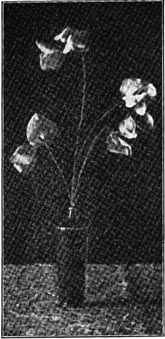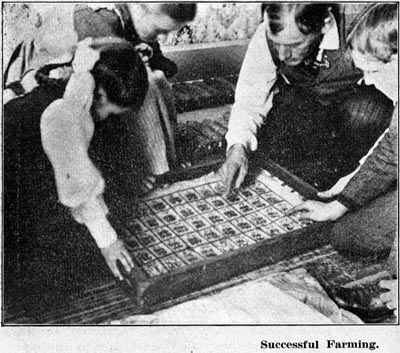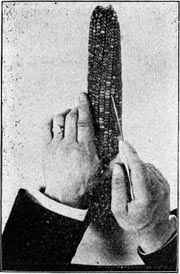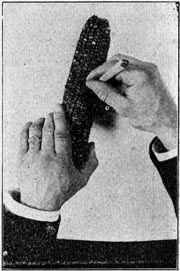NEGenWeb
Project
Resource Center
Schools
|
184
|
STATE SUPERINTENDENT'S REPORT
|
|
|
4. Sweet Pea Culture:
Mr. Val Keyser, of the
University of Nebraska, has written the instructions
necessary for the planting and care of sweet peas. Mr.
Keyser has made a specialty of horticulture work and it is a
privilege to the boys' and girls' clubs to be able to get
these instructions, which will be mailed to all members.
|

|
ANNUAL STATE MEETING OF THE NEBRASKA BOYS AND GIRLS
CLUB.
Lincoln, January 16-20, 1911
For the state meeting there will be
arranged a short course of one week in cooking, sewing, and home
nursing at the University of Nebraska, in the Department of Home
Economics. Arrangements will be made by which girls may be sent as
delegates from each county according to the plan arranged by the
county superintendent. The delegates from each county will be
permitted to enter the short course and receive free instruction
during the week. It is expected that a cooking contest will be held
in each county and that a Cooking Team of two girls will be sent to
the state meeting where they will compete with the teams from the
various counties, for which trophies or premiums will be
arranged.
For the boys, short courses in
agriculture will be offered, and judging contests conducted, in which
the boys' teams from the various counties will compete. Full
statements of plans will be given in announcements for the state
meeting.
Nebraska Boys and Girls Club -- Enrollment
Card.
___________________________
Name
|
___________________________
Town
|
__________
R. F. D.
|
__________
P. O. Box
|
____
Age
|
___________________________
County
|
___________________________
School Dist. No. or Name
|
___________________________
Teachers Name
|
I wish to enter the Home Experiment
Department and take the work as indicated by checks (x).
|
Domestic Science___________
|
Sweet Pea Culture___________
|
|
CORN: "Ear to Row" Test_______ ;
|
Acre Contest___________ ;
|
Husking Contest___________
|
|
POTATOES: Size of Seed-Piece"
Experiment___________ -;
|
Acre Contest___________
|
In recognition of pamphlets,
instructions, and materials received, I promise to follow all
directions as provided in the "General Outline and Plans of the
Nebraska Boys and Girls Club 1910-11," and make all required
reports.
Date ___________ 1910.
Signed ___________
Return promptly to State
Superintendent Public Instruction, Lincoln, Nebraska.
|
SERIES II.
|
BULLETIN No. 14.
|
AGRICULTURAL EDUCATION--HOW TO TEST SEED
CORN
For Nebraska Boys' and Girls' Clubs and Classes in
Agriculture
INTRODUCTORY
This bulletin is prepared especially
for the use of the members of the Nebraska Boys' Agriculture Club. It
is equally useful for others. No better educational work can be done
by the class in agriculture, the normal training class, or other
reliable pupils in rural and town schools than to construct a
homemade seed-corn tester and test a reasonable amount of seed-corn
for any seed-corn grower in the community who will bring in his corn
for that purpose. The corn should he carefully and accurately tested,
each ear separately, and a definite report made on each ear and every
ear returned to the owner. The patrons of the school and the farmers
in the vicinity will appreciate the kindness and the interest of the
school, and it will help them to recognize the fact that our schools
are providing instruction that has a practical as well as other high
educational value.
Please observe this suggestion:
Be sure that the test is so accurate and thorough that the owner
of the seed-corn may rely upon the result as indication of the actual
condition of his seed-corn as to germinating power.
B. C. BISHOP,
Superintendent
|
186
|
STATE SUPERINTENDENT'S REPORT
|
|

HOW TO TEST SEED CORN
By A. E. Nelson
I once heard a man say, "I don't
think there is anything a farmer can do that would so much increase
his yield of corn, for the money involved, as to test his seed." You
know the good book says: "Whatsoever a man soweth, that shall he also
reap. "Scientists say: "Like produces like." If these statements are
true, and they surely are, we have every reason to believe that we
could do much toward increasing the yield per acre in the state of
Nebraska by carefully selecting and testing our seed corn.
It takes only about twelve ears of
corn to plant an acre. Think what it means when one ear on each acre
of corn planted in the State of Nebraska fails to grow! The average
yield per acre is cut down one-twelfth before it is put into the
ground.
Directions are here given to make a
box large enough to test two hundred ears. This size box is
recommended so that the contestant will have a goodly number of ears
to select his seed from, also he can test a part of his father's corn
at the same time.
The cheapest and best way to test
seed corn is In a germination

The right way to remove kernels, insert
knife between the rows and pry sidewise.
|

The wrong way to remove kernels. By placing the
knife between the kernels and prying into the kernel, the
germ is sometimes injured.
|
box. Such a box can be made for testing two hundred ears by
following this outline:
The Germination Box
1. Make a box 48 inches long, 28
inches wide and 4 or 5 Inches deep.
2. Procure a good piece of muslin
one inch larger each way than the box.
3. Mark this muslin with heavy lines
into squares 2 inches by 2 Inches. Leave a margin of 4 inches between
the outside row of squares and the edge of the cloth.
4. Begin at the left of the upper
row of squares (top row first) and number the squares to the right.
The squares down the left hand side will then be numbered 1, 21, 41,
61, to 81.
5. Place 1 1/2 bushels of sawdust or
old chaff in a sack and soak well in warm water (at least 2
hours).
6. Drain and afterwards press
surplus water out of sawdust.
7. Place about 2 inches of sawdust
in the box and press firm and smooth with a brick.
8. Place marked muslin on this
sawdust and tack to box around edge.

|

|

|

|
© 2003 for the NEGenWeb Project by Ted & Carole
Miller
|







